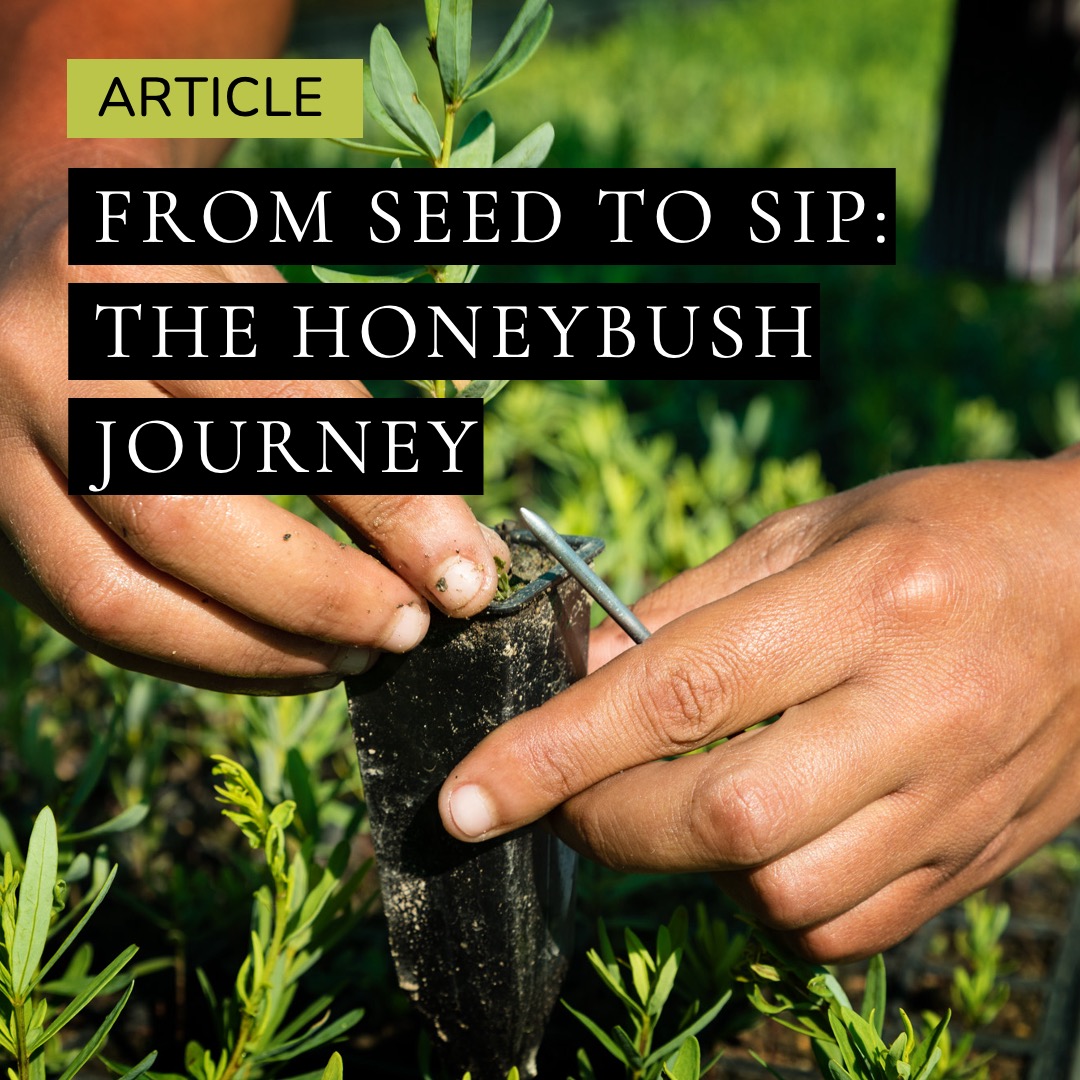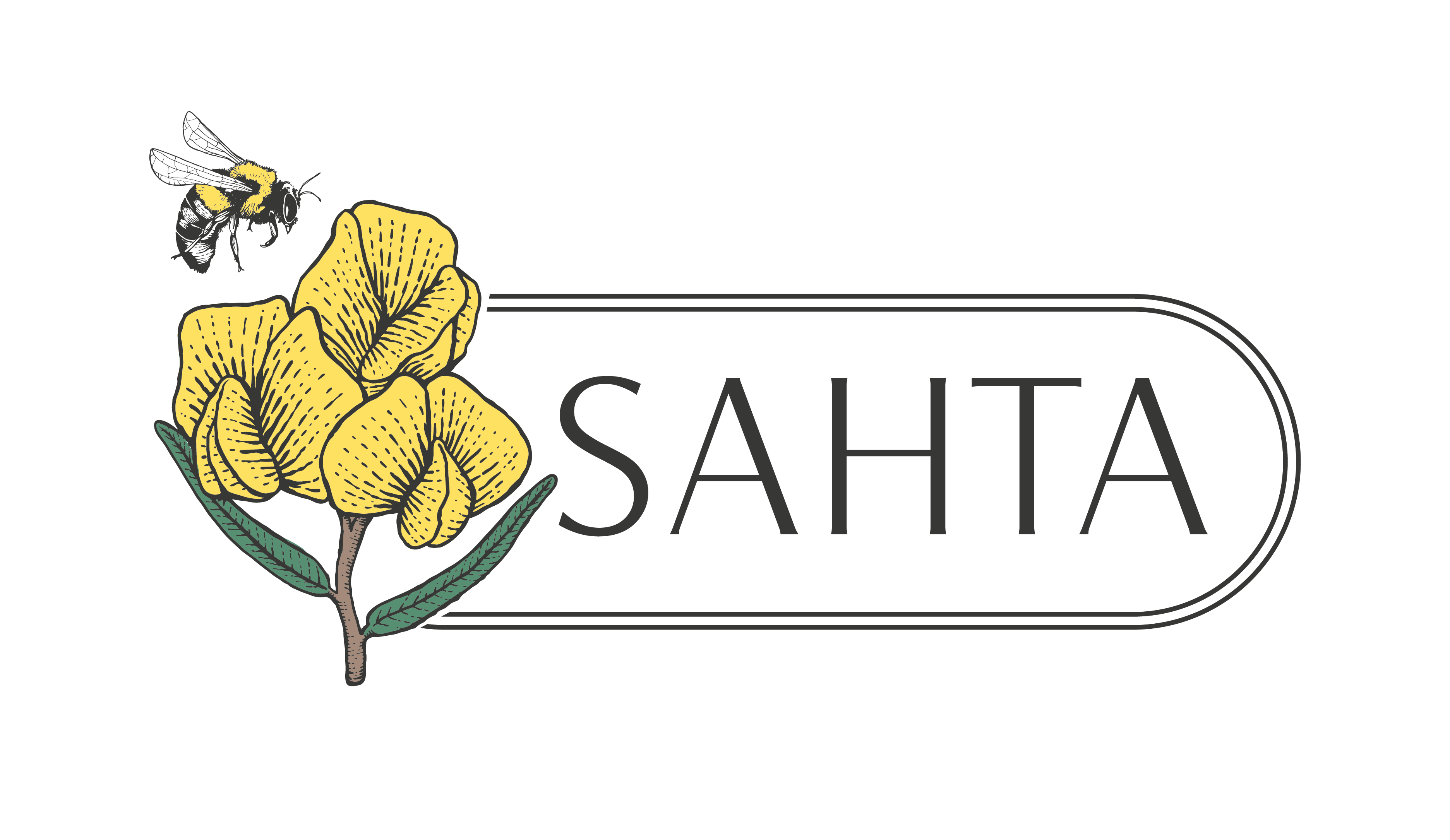
Honeybush grows in the wild across a widespread area stretching from Piketberg in the Western Cape to Gqeberha in the Eastern Cape. There are 23 species of honeybush, all part of the Cyclopia genus, each adapted to different environments with unique growth habits and survival strategies. However, only a few species are suitable for commercial cultivation. While honeybush was mostly harvested from wild populations, a handful of species have been cultivated on a commercial scale for the past ±30 years and now make up the bulk of production. The following species are currently used for commercial production (the first four are the most important commercial species):
• Marsh tea – Vleitee (C. subternata) – commercial cultivation
• Coastal tea – Kustee (C. genistoides) – commercial cultivation only
• C. longifolia – commercial cultivation only
• Mountain tea – Bergtee (C. intermedia) – mostly wild harvested
• Heidelberg tea (C. sessiliflora) – mostly wild harvested
• C. maculata – mostly wild harvested in the Genadendal region
Seeds: The Foundation of Honeybush Tea
The cultivation journey begins with the seeds, and selecting the right seeds is crucial for successful
cultivation of honeybush. It is not recommended to use seeds without knowledge of their quality
and source. Typically, seeds are harvested from plantations or seed orchards. During spring and early
summer, honeybush plantations burst into a bright yellow bloom with aromatic flowers that emit a
honey-like fragrance, which attracts the Carpenter bee that pollinates the flowers. After pollination
the flowers die off, and green elongated seed pods appear, each containing 4 to 8 seeds. The pods of
most commercial species generally ripen in November/December, depending on the climate.
However, it should be noted that C. sessiliflora flowers in winter, and the pods ripen in
September/October. In the wild, mature seed pods burst open after a few weeks, scattering seeds
nearby. Therefore, pods should be harvested before this happens. This requires that the maturity of
the pods should be regularly monitored; they should be brown/black with no green areas, hard, and
not fleshy. Seed pods are hand-harvested and then spread in a thin layer on flat cardboard boxes or
plastic sheets. The pods are covered with shade netting (or fabric) to prevent the seeds from
scattering when the pods burst open. After the pods open, the seeds are carefully separated from
debris, and stored in a cool dry place until they are needed.
Nursery and seedling production
Absorption of water is a requirement for the swelling and germination of seeds. The seed coats of
freshly harvested seeds are hard and prevent water uptake. In nature, seeds spend long periods in or
on the ground where micro-organisms, fires, wind, and weather gradually weaken the seed coat,
allowing water absorption. Harvested seeds need to be treated to weaken the seed coats to this
degree, a process called scarification. Various treatment methods are available. Treating seeds with
98% sulfuric acid has been effective, but wet heat treatment, an eco-friendlier option, is gaining
popularity. Wet heat scarification involves briefly dipping seeds into boiling water (100°C), producing
similar results to sulfuric acid scarification. Keep in mind that scarification treatment time varies
among species and the colour of the seed. (Fun fact: the seed color of honeybush varies from green
to a brownish color, called dimorphic seeds).
Seeds need to hydrate before they can germinate. After hydration, some species also need a cold
treatment, called stratification, for a specific period of time. While not all honeybush species have
been investigated, C. intermedia definitely needs this treatment, whereas C. subternata does not
strictly need it, but it helps the seeds germinate more evenly. If a species requires cold treatment,
this can be achieved by keeping the hydrated, air-dried seed in a plastic bag at 4°C for about 3
weeks.
While seeds can be sown directly into the soil (with C. genistoides being most suitable), it is more
common to sow the seeds in seed trays filled with a special growth medium. The best time to sow
seeds is between late summer and autumn to ensure optimum soil temperatures (15 to 25 ˚C) for
germination. These seeds typically germinate within 7 days and are kept in the nursery for about 4
months. Once the seedlings are about 10 cm high, the seed trays are moved to an area for another 2
to 5 months where they can acclimatise to the local climate but are still protected from harsh
conditions. The seedlings are then ready to be planted in the plantations.
Cultivation: Ideal Conditions for Honeybush
Honeybush grows in well-drained, sandy to sandy loam soils, making the cool, wet, southern slopes
of mountains ideal for planting. The soils are typically infertile and acidic (pH 4.0 – 5.0), with a
phosphorus content of about 15 mg/kg (but not more than 25 mg/kg) and low nematode counts.
Soil preparation is done about one to two months before planting by loosening it to an effective
depth of at least 30 cm using a ripper or other implements to break the soil. Dry land planting is
viable in high rainfall areas, but irrigation is necessary in areas with limited rainfall or long dry spells.
Regular weeding is essential to minimize competition for nutrients and water between plants and
weeds. Honeybush is a legume and forms nitrogen-fixing root nodules with Rhizobium bacteria in the soil.
This endosymbiotic relationship benefits both the plant and the bacteria: the plant provides sugar
and nutrients to the bacteria, while the bacteria supply nitrogen. About 10,000 seedlings are planted
per hectare, with spacing adjusted to local farm conditions and methods. Plants grow for about 18
months before the first harvest, and after that, the plants can be harvested annually for 6 to 7 years.
Resprouter forms like C. genstoides and C. intermedia are slow growing and under cultivated
conditions should only be harvested every 2 to 3 years. but will produce for up to 15 years.
Harvesting: Timing and Techniques
Honeybush can be harvested year-round, but generally, it is advisable to harvest before the plants
start to flower and produce seeds, as this process uses up a lot of the plant’s energy. It is important
to arrange with the processing plant in advance when you will deliver the harvested wet biomass.
Further, the Honeybush market demands residue-free products, so you need to ensure the plant
material is free of residues before harvesting. This involves laboratory tests like Multi-Residue
Pesticide Screening and Glyphosate testing. Only after the plants are confirmed to be residue-free
can harvesting begin.
Harvesting is physically demanding. Trained harvesters use pruning shears to cut off entire shoots
(including leaves, stems and twigs) and tie them into bundles weighing 15 to 20 kg. These bundles
are then transported to the processing plant within a day.
Harvesting methods are adjusted according to the different species and their specific growth habits.
For example, species like C. genistoides and C. intermedia can be cropped at ground level, while others like C. subternata and C. longifolia are pruned selectively or cut at a height of 50 cm to allow
them to recover and continue growing.
Processing: The Art of Transformation
At the processing plant, the bundles are chopped into a specific length using mechanised cutters,
such as tobacco cutters. The chopped plant material is then placed with a bit of water inside
stainless steel tanks to undergo oxidation (also sometimes called ‘fermentation’). This process
changes both the colour and the aroma and taste profile of the fresh plant material. The duration of
oxidation depends on the temperature, which can range from 60 to 90°C, with longer times needed
at lower temperatures. Typically, heated rotary tanks are used to ensure even heating and exposure
to oxygen. The process is complete when fruity-sweet, floral notes appear, and the predominant
grassy notes of the freshly chopped plant material are mostly gone. During oxidation, the leaf colour
changes to brown. The optimum oxidation temperature and time combination depends on the
specific Cyclopia species. By adjusting these conditions, the aroma profile of the final herbal infusion
can be adjusted to be either more floral-like or predominantly sweet to fruit-sweet.
There is a market for green honeybush, which has a different taste. To make green honeybush, the
chopped plant material is dried directly, skipping the oxidation step. An advantage of omitting
oxidation is that the levels of health-promoting compounds in the herbal infusion are much higher
than in the conventional, oxidised herbal infusion.
Drying and Grading
Honeybush herbal infusion can be dried either by sun-drying or artificial drying. Sometimes, wood
from alien invasive trees like Black Wattles is burned to generate heat. Honeybush is dried to less
than 10% moisture content to prevent microbial growth. As an additional safeguard, each batch of
herbal tea is tested to ensure that it meets the low microbial levels specified by regulations.
The next step is to remove fine herbal tea dust and to separate the dried honeybush material into
different coarseness grades. Dust is removed to prevent turbidity or a sediment in the final
beverage. Fine cut is used in tea bags, while the coarse cut is sold as Loose Leaf Honeybush Herbal
Tea. The dust can be used to make Honeybush cappuccinos.
Laboratory Testing
Each batch of herbal tea is tested by accredited laboratories for microbial and chemical residue
levels, and any other tests requested by the customer. A full set of paperwork, including laboratory
test results, certification, permit numbers, and export documents, accompanies each bulk order of
herbal tea. Additionally, a retention sample of each batch of herbal tea is kept in storage by the
processor for a period of time in case any of these results are disputed.
Packing and Shipping
Honeybush of different coarseness grades is packed into food-grade bulk bags (~20kg) and labelled
with all relevant information, such as the honeybush species name, cut type, certification status and
field of origin. Additionally, some of the herbal tea is packed into retail packets. Stocks are stored in
a cool, dry place, away from direct sunlight to ensure that quality is preserved until it is shipped.
Finally, the product is on its way to the market where eager customers are waiting to sip on their cup
of honeybush herbal tea.
Written by Cecilia Bester and Lizette Joubert
